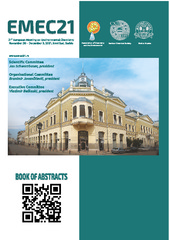Приказ основних података о документу
Biodegradation Assessment of Poly(Urethane-Dimethylsiloxane)/Organoclay Nanocomposites under Environmental Conditions
| dc.creator | Pergal, M.V. | |
| dc.creator | Gojgić-Cvijović, Gordana D. | |
| dc.creator | Kodranov, Igor D. | |
| dc.creator | Manojlović, Dragan D. | |
| dc.creator | Špírková, M. | |
| dc.date.accessioned | 2022-03-03T11:00:47Z | |
| dc.date.available | 2022-03-03T11:00:47Z | |
| dc.date.issued | 2021 | |
| dc.identifier.isbn | 978-86-7132-078-8 | |
| dc.identifier.uri | http://cherry.chem.bg.ac.rs/handle/123456789/4926 | |
| dc.description.abstract | The first series of polyurethane network nanocomposites (PUNN) was prepared by in situ polymerization [1,2] from poly(dimethylsiloxane)-based prepolymer as the soft segment and 4,4’-methylene diphenyldiisocyanate and hyperbranched polyester of the third pseudo generation as the hard segment, in the presence of organically modified montmorillonite nanofiller (Cloisite 30B; 0.5 wt.%). The second series of pure polyurethane networks (PUN) without organoclay was also prepared. The composition of prepared materials in both series was varied through variation of soft segment content from 30 to 60 wt.%. Biodegradability of prepared materials was measured using mixed cultures of microorganisms that originated from soil. This test used soil bacteria and fungi to assess the impact of the environment on polymer compounds. This test is intended to determine which polymer compositions are best suited for coating other materials that must endure lengthy exposure to harsh environmental conditions while retaining their principal functionalities. The biodegradation test was performed under aerobic conditions in the dark condition and in a thermostat at 28 °C. Bacterial and fungal mixed cultures were alternated monthly. After 3 and 6 months of the test, the materials were washed with water, dried in a vacuum oven to constant weight, and used for gravimetric measurements of weight loss. The prepared materials before and after biodegradation test were characterized by FTIR spectroscopy. The results showed that pure PUNs (18.35-18.66 wt.% after six months) possess the highest weight loss as compared to PUNNs (from 7.53 to 14.78 wt.% after six months) after incubation of up to six months. PUNN films had lower biodegradation degree as compared the pure PUN films. Biodegradability was lower for materials with lower soft segment content. In FTIR spectra of PUNN after biodegradation differences were noted at approximately 1700-1735 and 3324 cm-1. The structures contributing to strong hydrogen bonds were partially destroyed during the biodegradation process. The results showed that PUNN with 40 wt.% of soft segment (PUNN-40) is the most resistance material to biodegradation. The reason was probably due to more hydrogen bonding between the polymer and Cloisite 30B organoclay and its better mechanical properties of PUNN-40 sample as compared to other prepared PUNN materials. The obtained materials are good candidate as top coating materials exposed to the environmental conditions. | sr |
| dc.language.iso | en | sr |
| dc.publisher | Belgrade : Serbian Chemical Society | sr |
| dc.relation | info:eu-repo/grantAgreement/MESTD/inst-2020/200026/RS// | |
| dc.relation | info:eu-repo/grantAgreement/MESTD/inst-2020/200168/RS// | |
| dc.rights | openAccess | sr |
| dc.rights.uri | BY | |
| dc.source | Book of Abstracts 21st; European Meeting on Environmental Chemistry | sr |
| dc.title | Biodegradation Assessment of Poly(Urethane-Dimethylsiloxane)/Organoclay Nanocomposites under Environmental Conditions | sr |
| dc.type | conferenceObject | sr |
| dc.rights.license | BY | sr |
| dc.citation.spage | 154 | |
| dc.citation.epage | 154 | |
| dc.type.version | publishedVersion | sr |
| dc.identifier.fulltext | http://cherry.chem.bg.ac.rs/bitstream/id/29064/EMEC21_154.pdf | |
| dc.identifier.rcub | https://hdl.handle.net/21.15107/rcub_cherry_4926 |


